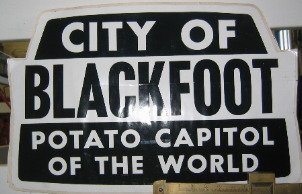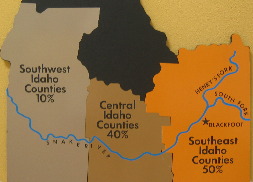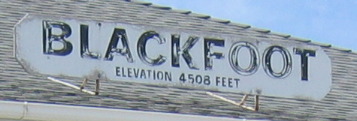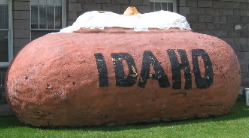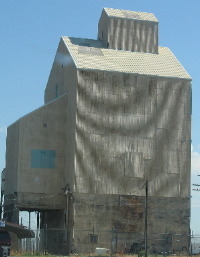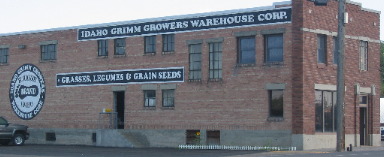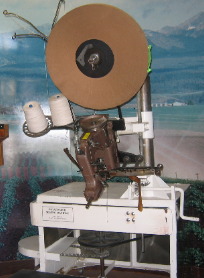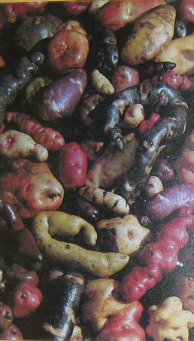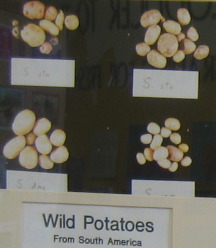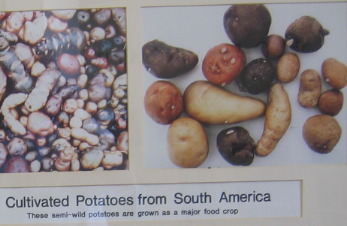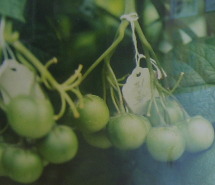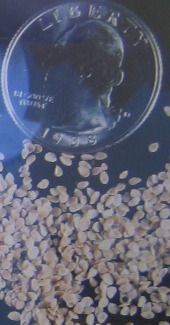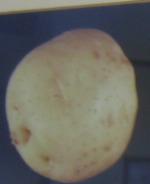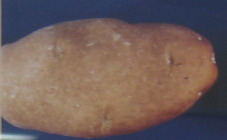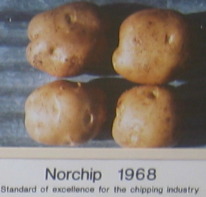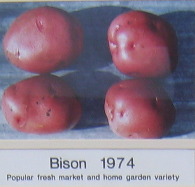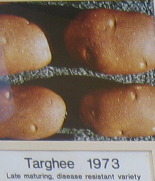Places Visited: Idaho: The Potato Expo in Blackfoot. July 25 & 26, 2006: Cowboy RV-Park in Pocatello, ID 208-232-4587 N42° 50.965' W112° 25.146 $26.25 Full hookups with 50-amps. Paved interior roads and pads. Very nice and clean park with an air conditioned laundry.
We headed to Blackfoot this morning where we stopped by the Idaho Potato Expo. The map on the right shows southern Idaho and gives the percentage of Idaho potatoes grown in each area. As you can see Blackfoot is in the center of the southeast region that produces 50% of Idaho's famous potatoes.
Blackfoot is a small town in southeastern Idaho in the center of Idaho's most productive potato growing area and home to the Idaho Potato Expo where we were stopping by for a visit.
This area may be billed as potato country but potatoes aren't the only thing grown here. In fact potatoes are only grown every third year with grain or alfalfa being grown the other two years. That means there is a lot of hay and grain produced here also. Every town has grain elevators and silos as does every large farmer. This Idaho Grain Growers Warehouse Corporation building attest to the fact that a lot of grain is grown in these parts.
Inside the "Expo" we saw all kinds of neat equipment. This is the sewing machine used to sew the tops of bags of potatoes.
Potatoes have been a part of our daily meals for hundreds of years. The average American eats 49 pounds of fresh and 90 pounds of processed spuds each year, making the potato one of the most poplar side dishes in the United States, baked, fried, scalloped or mashed-chances are the potatoes you eat were grown in Idaho. Idaho produces more potatoes than any other state, and that adds up to be about 30% of the nation's total production. In Bingham County (Blackfoot) alone, over 20 million 100-pound sacks are harvested every year, making this the potato capital of the world. Some of the best growing conditions are found in this region of the country. Scientists consider this an "optimum growing region" due to consistent warm days and cool nights, rich volcanic soil, and plentiful irrigation water supplied by the Sanke River Aquifer. In the 1860's, Mormon pioneers forging north from salt Lake City settled the first farmsteads in southeastern Idaho. Potatoes had been a staple of the Western migrations; quite naturally they remained an important crop. Settlers in the 1860's found a ready market for their potatoes in the mines of Montana and Idaho. The reliable potato, which thrived in the climate of the region, provided sustenance for mineral seekers, and a source of income for the settlers. The building of railroads expanded the market for potatoes, and brought in more settlers and the machinery for developing agriculture in the Sanke River Valley. Railroads provided the means for exporting the crop. Idaho potatoes were marketed in California as early as the mid-1870's which is very soon after the completion of the Transcontinental rail road in 1869 that made the Salt Lake Valley the "crossroads of the West". Potatoes began to be grown on an even larger scale in Idaho in the 1880's when the Oregon Short Line Rail Road was completed, opening a nationwide market for superior Idaho potatoes. Potato growing in the 19th century was done entirely by hand. A common shovel was used to plant each seed piece in the ground worked with a horse and walking plow. Growing plants were hoed by hand, and often the planting shovel became the harvest tool. Potatoes were picked by hand and carried off in baskets or burlap sacks to the cellars, all by manual labor. By the turn of the century, advances in transportation and farm machinery put one and two-row horse drawn planters and potato diggers in the hands of Idaho farmers, but production still depended on hard, physical labor, from battling weeds and pests to flooding irrigating, which depended on a complex system of canals and ditches. Harvest continued to be stoop-labor in spite of mechanized digging. Small armies of laborers which included school children of all ages picked potatoes from the ground into baskets and burlap sacks. "Half-sacks" weighing fifty to sixty pounds were loaded onto wagons for transfer to the cellars. In the 1800's a horse drawn planter was used. One person on the back of the planter kept moving slots filled with potato eyes (seeds). Shoes cut a grove for the seed to fall into. Two disks followed covering the seed. A press wheel pressed the moist soil around the seed piece, but left the soil in the center loose for easier emergency on the potato plant. A lever on the back corner took the clutch out to enable the planter to turn around without planting potatoes. This pattern of work changed little for decades. The tractor gained farmers certain convenience, enabling the mechanization of more processes, but hand-picking and field sacking remained common into the late 1950's. About that time, the development of sprinkler irrigation supplied by large wells sunk for the purpose expanded farming into areas which could not readily be flood irrigated. Concurrently with these irrigation advances, "combine" harvesters became available which loaded potatoes directly from the digger chain into bulk trucks. Combines vastly improved harvest efficiency, handling methods, and quality. For forty years, the trend has been toward increased acreage, larger machines and more efficient methods. Farm economics have relentlessly pressed growers to attain higher and higher levels of efficiency. The absolute minimum labor and capital is invested to produce potatoes at market prices insubstantiality higher than those paid during the Great Depression (1929-1940). Potatoes are one crop which has never been subsidized by the state or the Federal Government. Spanish explorers reached Peru in 1537. Although the Conquistadors came for gold, the potato proved to be the richer treasure exported to Europe. Gold from the Americas built the Spanish empire which had failed by the end of the 18th century, but potatoes became a food source for millions of people. On landing in South America, the Spaniards found natives growing potatoes on terraces and raised beds under elaborate systems of cultivation. Spanish sailors brought potato plants home to Spain and Portugal. Cargo manifests of ships entering Sevilla from the New World document the arrival of the potato in Spain c.1570. Potatoes were introduced into Italy c.1587 by Carmelite Monks. By 1600, potatoes had spread to France and then to most of Europe. The British and Portuguese brought potatoes along when they colonized India and China in the 1600's, and from there they reached Japan and other Asian countries.
Native potatoes from Andean regions grow in astonishing variety.
Potatoes originated in the Andes mountains of South America. Native peoples cultivated them about 200 BC, and were first to dehydrate potatoes, producing "chuno". Chuno is made by exposing the small Andean potato to alternate freezing and thawing, which yields a dry, stable food high in protein and carbohydrates. In the Altiplano of Peru at about 13,500-feet present-day farmers make chuno during winter (June, July south of the equator) when relative humidity is low, night temperatures drop to -2 degrees F and daytime temperatures reach 76 degrees F. Freezing causes water to crystallize and leave the potato. Daytime solar heat evaporates the water, leaving the product totally dry. Farmers then soak the potato in water and peel it before further drying and storage. Chuno remains a dietary staple for many in the region.
Convinced of the potato's value, Frederick II of Prussia commanded German peasants to eat them. Frederick the Great of Prussia grew potatoes in his flower garden c.1750 because he found the flowers beautiful. However, Frederick II was so convinced of their nutritional value he threatened to cut off his subjects' ears if they refused to grow them. Potatoes were also planted by decree in Russia in 1765. Christian VII of Denmark tasted his first potatoes in 1770. Potatoes had arrived there with immigrant French Huguenots in 1719, then promptly spread through Scandinavia. Potatoes became immediately fashionable in France when Marie Antoinette began wearing potato blossoms in her hair. French fries are indeed the invention of French chefs, who were first to deep-fry potato slices. This manner of cooking potatoes now accounts for half of all the potatoes eaten! Potatoes became a staple crop throughout Europe by the end of the 18th century. The story of the creation of potato chip is a fascinating one, and it all began by an error. About 120 years ago, Saratoga, New York was a very popular vacation spot, and one of the many large hotels there was Moon's Lake Hotel. One of the guests there was a very critical person, especially in the matter of food served him. He constantly complained and grumbled about the fried potatoes he was served, and he frequently ordered the waiter to return them to the kitchen. In another attempt to please this man, the chef burned the potatoes to a crisp and, in frustration, decided to send them out anyway. The guest was delighted - and that is the way potato chips were discovered. Guiness Book of World Records lists the world's largest potato as weighing 18 pounds 4 ounces on February 17, 1795. It was grown in Chestere, England. The worlds largest potato yield from a parent seed weighed in at 515 pounds in 1977. Thomas Jefferson gets the credit for introducing "French Fries" to America when he served them at a Whitehouse dinner. The average American eats 142.7 pounds of potatoes each year: 48.1 pounds of fresh potatoes, 58.9 pounds of frozen - French fries, hash browns, etc., 16.0 pounds of potato chips, 18.0 pounds of dehydrated in mashed potato flakes, au gratin mixes, etc. and 1.7 pounds of canned potatoes. According to legend, the potato had to cross the Atlantic seven times before it became popular in the American colonies. General Washington's cook kept the troops satisfied during the American Revolutionary War with a hearty soup, "Philadelphia Pepper Pot." The ingredients: tripe, fatback, pepper, and of course, large amounts of potatoes. The Spanish discovered the potato in 1537 and carried some on a return trip to Europe. The vegetable had a hard time being accepted. It was considered to be poisonous or evil in England by the Society for the Prevention of Unwholesome Diets, or SPUD., hence the nickname. The potato is the only vegetable that grows in the desert as well as in the mountains above 14,000 feet. The earliest known potatoes were discovered in the high mountains of South America. The earliest such remains of potatoes date to 400 B.C.
The potato family is remarkably varied with an assortment of tuber shapes, sizes, and colors. Although many relatives of the cultivated potato are not acceptable for agricultural use, they do offer valuable traits such as disease resistance and frost tolerance. These potatoes may be used in a breeding program to incorporate desirable characteristics into a marketable variety. Below are some wild potatoes and cultivated varieties that have been released through the years.
Potatoes actually have flowers and fruit (berries) containing thousands of true potato seed. Seed is extracted from the berries.
Potatoes grown from each true seed are genetically unique and subject to all genetic laws of inheritance. In contrast, potatoes grown from seed pieces (eyes) are clones and have the exact characteristics of the potato from which it originates.
To develop new varieties, potato breeders cross parents with different characteristics to form true seed. Parents with desirable traits are selected.
After years of intense selection, the new varieties are ready for release. These are three recent releases from the University of Idaho breeding program.
Norchip is the favorite for making potato chips. While the red "Bison" is popular with home gardeners.
The Targhee is noted for late maturing and disease resistance.
Potato vines are killed about three weeks before the tubers are to be harvested. This allows time for the skin of the potato to mature. Vines are killed by special machines which chop or beat them down. Sometimes, vines are killed by crushing them with wide rollers. Some growers apply chemicals which kill the vines. Many years past, the harvest would be delayed until a killing frost had eliminated the vines, but nowadays, the demands of modern production mean growers can't afford to wait for Mother Nature's help. To produce a good crop, potatoes require the equivalent of twenty-four inches of rainfall during the growing season. Depending on soil type, water is applied once a week or as often as necessary to maintain optimal moisture content in the soil. Nowadays, potatoes are almost always irrigated by sprinklers as opposed to flood irrigation which was used formerly. Sprinkler irrigation systems are of several different types: center pivots, wheel lines, set lines moved by manual labor, and solid set lines. Each system has its own advantages and disadvantages. Potatoes are grown from their own tubers, not from seeds like most other crops. Potato crops are not produced from seeds such as those which produce wheat, or corn, or beans, or most other plants. Instead, potatoes are planted from the potatoes grown the previous season. Small potatoes are used whole, and larger ones are cut into "seed pieces" about the size of a golf ball. Each piece must have an "eye", that part of the tuber which will sprout to produce a potato plant. The potato is sometimes mistakenly referred to as a "root", but the botanical term for this plant structure is "tuber". Tubers are actually specialized underground stems. Potato plants produce better when grown in sequence with other crops. This practice is called crop rotation. The most common rotation in eastern Idaho is two years of grain (wheat or barley) and then potatoes. Sometimes potatoes are grown every other year. In Idaho, other rotation crops include alfalfa and beets. A field which is given more years to grow other crops in-between potato plantings will generally yield better quality potatoes more abundantly. Grain often precedes potatoes. In the fall the ground is disked, then ripped with a chisel plow. When a grain crop parricides the planting of potatoes, remaining straw stubble is chopped in the fall, then lightly irrigated to germinate any seeds left in the field. The straw is then plowed or disked into the soil. Next, the soil is loosened to a depth of eighteen inches using a chisel plow or "ripper", and the field is "laid by" until spring. In the spring, the field is harrowed to loosen the surface soil and conserve moisture in the seed bed. Rows are marked out, often at the same time a starter fertilizer is applied, and the field is ready for planting potatoes. The potatoes first introduced into North America were likely brought from Ireland. From Bermuda, the English brought "Irish" potatoes to Virginia in 1621. The name "Irish Potato" serves to distinguish white potato varieties from the sweet potato. Famous the world over, the "Idaho Potato" is the Russet Burbank variety. Luther Burbank, is the well-known American botanist who developed the "Idaho Potato." Nearly all potatoes grown in Idaho are the Russet Burbank variety which originated from a single seed ball that Luther Burbank discovered growing in a New England garden in 1872. The seed ball appears as a "fruit" on the potato plant. Burbank took seed from this Early Rose (variety) plant, although the variety does not commonly set fruit. Burbank planted the seeds as one would plant the seed of beets or cabbage. Two seedlings of those that emerged showed improved characteristics over their Early Rose parent. One plant of the two was distinctly superior for yield and tuber size, producing two to three times as much as the commonly grown varieties of the time. The Idaho Potato Expo has a letter dated 1905 documenting payment of $5.00 for Russet Burbank seed stock, an early introduction of this superior variety into Idaho. If you ever find yourself in southeast Idaho stop by the Potato Expo in Blackfoot. It is a great place to visit. Until next time remember how good life is. Mike & Joyce Hendrix
|
| ||
